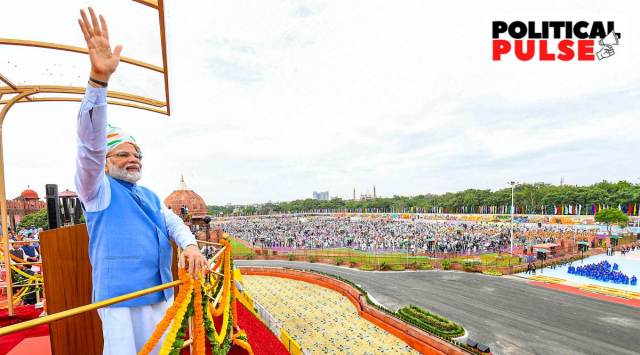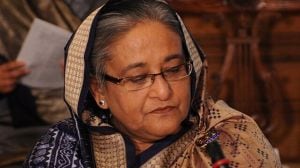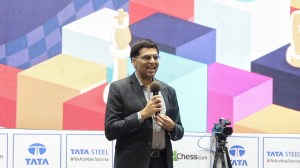The federalism debate: From Constituent Assembly speeches to Centre vs state relations in independent India
While PM Narendra Modi called for cooperative federalism, Congress accused BJP of practising "destructive federalism", alleging Centre interfered with jurisdiction of states on several issues
 Prime Minister Narendra Modi after addressing the Nation on the occasion of the 76th Independence Day from the ramparts of Red Fort, in New Delhi. (PTI Photo)
Prime Minister Narendra Modi after addressing the Nation on the occasion of the 76th Independence Day from the ramparts of Red Fort, in New Delhi. (PTI Photo)In response to Prime Minister Narendra Modi’s Independence Day speech in which he spoke about cooperative federalism, the Congress accused the BJP of practising “destructive federalism” instead.
Party spokesperson Gaourav Vallabh alleged the Centre interfered with the jurisdiction of states on several issues, including agricultural laws and deployment of paramilitary forces in border states, adding, “The prime minister says whatever good is happening, it is to his credit. If anything goes wrong, he says it is the responsibility of state governments to speak on.”
What exactly is cooperative federalism and how has it figured in political discourse over the years?
Among the first instances of India discussing federalism was at the First Round Table Conference in 1930, but it took shape with the Government of India Act of 1935, when the British government provided certain subjects in what they called a “provincial list” for provinces at the time to legislate upon.
However, the Act was seen as a move by the British to delay freedom to India and the clauses did not become operative, according to various reports.
Subsequently, when World War 2 broke out, Indians were swept into the war on behalf of the British. Indian leaders demanded answers and started the non-cooperation movement.
Federalism found a place again in the Cabinet Mission Plan of 1946 proposing a “federal union” in which the Centre was to have three subjects of legislation – defence, external affairs and communication – and the states or the provinces would keep all the other powers.
But Partition in 1947 and its aftermath led to a changed approach — “a federation with a strong Centre”.
The debates in the Constituent Assembly, formed in August 1947 in the wake of Independence, saw varying opinions on the influence of the Centre and how federalism would be characterised in Independent India.
This is clearly echoed in one of the statements made by veteran Bihar leader Brajeshwar Prasad, who said in one of the Constituent Assembly debates, “I am opposed to federalism because I fear that with the setting up of semi-sovereign part-states, centrifugal tendencies will break up Indian unity. Provincial autonomy led to the vivisection of the country. Federalism will lead to the establishment of innumerable Pakistans in this sub-continent.”
On the other hand, the unitary aspect was also being questioned. Congress doyen T T Krishnamachari asked to “apply a simple test” with three criteria: “states must exercise compulsive power in the enforcement of a given political order”, that “these powers must be regularly exercised over all the inhabitants of a given territory”; and the third – what he called the most important – was “that the activity of the State must not be completely circumscribed by orders handed down for execution by the superior unit.”
B R Ambedkar, who was the architect of the Constitution, said the “basic principle of federalism” was that “legislative and executive authority” was partitioned between the Centre and the states “not by any law to be made by the Centre but the constitution itself.”
As per Article 1 of the Constitution, India is a “Union of States”, with no mention of the word ‘federal’. There is a clear demarcation of powers accorded to the Centre and state through the Union, State and Concurrent lists.
However, the demarcation of the lists came in for criticism, especially in the context of the Centre gaining the upper hand in the concurrent lists and also upon subjects of the state list if it gets a two-thirds majority in the Rajya Sabha and declares that a subject is of national interest.
Ambedkar said in one of the debates, “We must resist the tendency to make it (Centre) strong. It cannot chew more than it can digest. Its strength must be commensurable to its weight”.
The debate of an overbearing Centre came up in the 1950s when the Planning Commission was set up. Research notes that the commission started disbursing funds and development plans for the states, with schemes becoming centralised.
Then Tamil Nadu chief minister Annadurai said: “The powers which the Central government has assumed in regard to mobilisation, allocation and pattern of utilisation of resources of the Plan have reduced the states to the status of supplicants for and from the Centre”.
During her reign, Indira Gandhi deployed Article 356 of the Constitution several times — the first instance being dismissing Kerala’s Communist government in 1959 — which says that a Union government can take direct control of the state machinery if a state government is unable to function according to constitutional provisions.
As per the 1983 Sarkaria Commission, set up to examine Centre-state relations, Article 356 was employed over 90 times since Independence, primarily for political reasons.
The S R Bommai versus Union of India judgment is considered a landmark one in this respect, when the Supreme Court ruled that the President – who until then had the sole power to impose the rule – had to take consent from both Houses of Parliament from then on, and that the decisions were subject to judicial review, among others.
The conversation on federalism has become even more charged with Modi coming to power in 2014 and in 2019, with the party controlling 17 states at the moment.



- 01
- 02
- 03
- 04
- 05




























